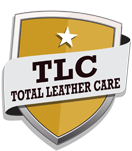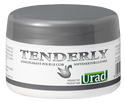How to clean and condition leather furniture?
Furniture and Upholstery Leather (part 1)
Description, Definitions and
How to choose the right leather?

How to choose the right leather?
Introduction
To install at home a 3 piece leather furniture set is equal to letting in the house 7 cows! Leaving aside possible manufacturing defects, no two animal skin can have identical aspects.
Skin is a natural product on which is written the complete life of the animal. To expect a bull skin with no defects is just as utopian as to expect an aged man to have baby skin.
Through successive sorting, the tanner finds the skins that are best suited and for each, the most appropriate tanning method. While major defects cannot be accepted in the center of a cushion, minor defects can be hidden with the Full Grained Pigmented tanning process. These requirements, specific to leather furnishing, justify in part why the raw materials account for a large portion of the cost of any leather furniture piece.
The raw material :
Animal species
Cattle accounts for the major part of skin supplies in leather furnishing.
- Cow and bull
- Skins from Northern Europe, Germany, Switzerland and Austria are most valued for having breeding conditions and slaughter methods resulting in skins with very few defects.
- Calf
- Its full grain (part of the skin used to make leather) is remarkable for its softness but is more fragile than one of an adult animal.
- Buffalo
- Buffaloes love wetlands where parasites are in volume. Wildlife conditions of these animals can leave many visible defects and result in depreciated value of their skins. That is why today, the essential part of buffalo skins are from young breaded animals. The impressions on buffalo's skin grain are made by the implantation of wide and regular hair shafts. Through various methods, the grain can be accentuated to give a more rustic aspect to the leather.
Aside from calf skin, more fragile, other cattle skins are pretty much equal when it comes to strength and resistance. Essentially, the difference lies in the surface aspect. These differences depend as much on zoology then on the art of tanning. The tanner's know-how and the furniture maker's skills are precisely what makes it possible to best exploit the raw material.
And a great paradox it is: skins are sub products taken from the slaughter house left overs, but because of the craftsmanship of the tanner, the leather which comes out of his workshops is one of the noblest products there is!
Defects
The more flaws in the skin, the more work needs to be done to obtain an acceptable leather finish. The common defects found in cattle hides are :
- Parasitic defects
- Structural defects (Example : wrinkles)
- Traumatic defects (Example : scars)
- Manipulation defects (Example : stretch marks when skin is separated too brutally)
The types of leather defined

The difference between leather Grain and the Split illustrated
Labeling which specify the type of material, the animal species and the finishing of the leather product should be standardized and encouraged. But still today, rare are those manufacturers who follow these guidelines...
Before you make a purchase, don't hesitate to ask for any and all essential information pertaining to the leather article. This can include having the type and quality of the leather written directly on the bill.
Here is a good naming convention :
Full Grain Aniline
- Definition
- A leather which has kept its full grain, has a naturally textured full pored surface. The deep aniline coloring is achieved with dyes. It may or may not have a thin transparent finishing coat.
- Our point of view
- This leather is of the highest quality and is the most expensive. Only flawless skins undergo such a treatment. Not well protected, these leathers darken well with age but remain fragile. Not recommended if you have children or a cat.
Full Grain Pigmented (often also called Top Grain)
- Definition
- This leather has also retained intact its full grain but has received, on top of a penetrating dye, a colored opaque finishing which gives a unified appearance, hides small defects and protects the leather.
- Our point of view
- Only high quality raw-hides are used. This treatment makes leather pleasing to look at and to touch, and makes it resistant. It's the best compromise between esthetics and resistance.
Corrected and Pigmented Grain
- Definition
- To smooth out the leather surface and to eliminate its imperfections, wrinkles, scratches… The skin is slightly pounced and a tinted grain film is applied to its surface.
- Our point of view
- These leathers are not of the highest quality and they have a slightly artificial appearance. The surface coating, however, is quite resistant to heavy wear.
Pigmented splits
- Definition
- This is the lower part of the dermis, to which a thick artificial layer was applied to its surface and embossed with a leather grain. Splits are also used to make suede. Spits do not have the right, in this naming convention, to be called leather. Splits do not perform well in furnishing.
- Our point of view
- Should not be used on the seating parts or the armrests of any leather furniture. Mixed with other materials, spits are sometimes used on the frame of some leather coaches and if of a good quality, they can perform decently in those areas. However, as a general rule, there are not recommendable in furnishing.
Nubuck
- Definition
- The velvety appearance of this leather is obtained by a light pouncing of the skin thus highlighting the grain and the pores of the leather. CAREFUL: not to be confused with suede (made from splits Zoom image). Sometimes one finds Nubuck cushions and a suede understructure on the same sofa. If used on either the base or the back of the sofa the suede can work well, however, a combination of Nubuck and suede is not advised. They do not age the same way over time and may not change color the same way.
- Our point of view
- To obtain a good-looking Nubuck a quality skin is generally used. It's a pleasant material, soft to the touch with velvety colors. Nubuck is fragile and requires careful maintenance. A waterproofing treatment is mandatory. It remains a costly material.
NOTES:
- The first three types can also be embossed and still have the right to their respective name. (Example Embossed Full grain Aniline)
Conclusion
A good understanding of the terms used in the making of leather can save you lots of troubles and enable you to make an enlightened choice as to the right balance of quality-price-durability.
Before moving on to the second part of this article, it is worth noting once more that leather is a natural material and a certain amount of ware is most normal. For example, light-colored leather will tend to become darker, whereas darker leather will tend to lighten over time. Certain conditions will accelerate this phenomenon: being exposed to direct sunlight, to a heat source or too heavy humidity are particularly damageable to leather furniture. Also, once leather is “burned” it can never completely be restored. Thus, it is advised not to expose your leather furniture to these conditions. If it cannot be avoided, you should give special attention to the moisturizing step and in general, you should perform the regular maintenance steps more often.
However, remember that the better the quality leather is, and the better its maintenance was performed, the more chance you have to have leather gain more richness and texture over time, as it ages. So without further due, it seems appropriate to introduce the essential notions of caring and maintaining leather furniture.
How to clean and condition leather furniture?
















